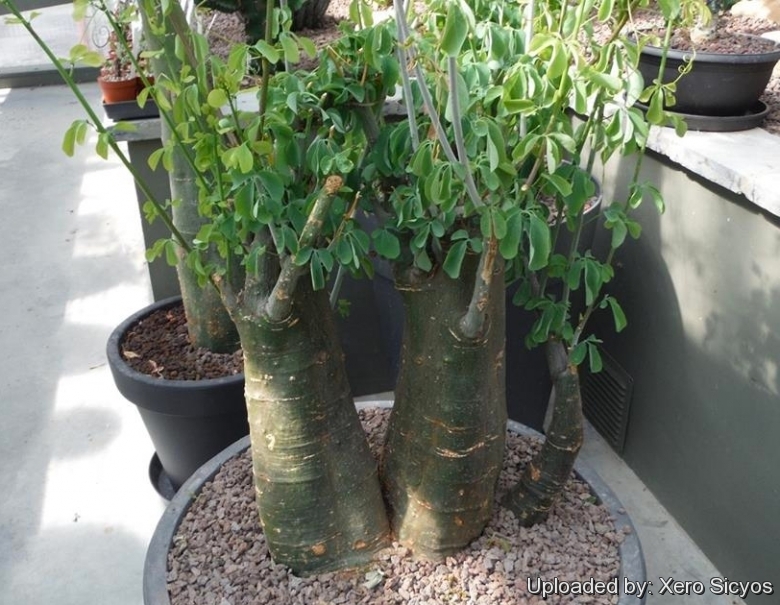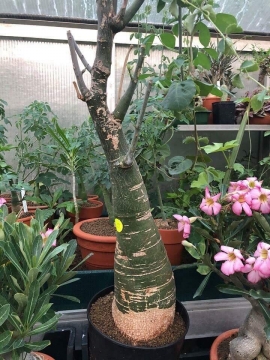
Adenia fruticosa Photo by: Xero Sicyos
Origin and Habitat: Adenia fruticosaSN|3567]]SN|3567]] is endemic to Limpopo and Mpumalanga, Strydpoort Mountains southwards to Ohrigstad and the Steelpoort River Valley. (Sekhukhuneland), also in Zimbabwe?. Extent of occupancy 5900 km², A of occupancy <2900 km².
Altitude range: 100-1400 metres above sea level.
Habitat and ecology: This species grows in dry savannas and thorn bushveld on rocky hills or mountain slope and near hot springs, usually on sandy or rocky well-drained soils on dolomite, granite and quartzite. There is a continuing decline in the habitat, but population reduction is unlikely to exceed 30% within the next generation (50 years) as this subspecies also occurs on rocky slopes in more remote mountainous areas that are unlikely to be impacted by development and agriculture, and more than 10 locations remain. It is used for traditional medicine, but is at present not harvested in large volumes for the commercial muthi markets.
Synonyms:
See all synonyms of Adenia fruticosa
Common Names include:
ENGLISH: Sekhukhune Greenstem, Green-stem
AFRIKAANS (Afrikaans): Sekoekoenie-bobbejaangif
Description: Adenia fruticosaSN|3567]]SN|3567]] is a remarkable scrambling succulent shrub or shrubby tree, 1-2 m tall, occasionally to 6 m with a distinct cluster of grotesque, irregularly club-shaped, softly woody stems and unarmed branches. The swollen stems are flask-shaped and smooth, up to 1 m in height and ending into a few thick whip-like branches. The bluish-green leaves are simple or digitately 3- or 5-foliolate. The flower is bell-shaped and the corona has fine dense hairs. The plants are dioecious (sexes on separate plants).
Derivation of specific name: Latin fruticosa = shrubby.
Main stem (Caudex): Little more than a much swollen "trunk", tuberous, somewhat sprawling and roughly conical or club-shaped, thickset, up to 40-60 cm in diameter, succulent, soft, woody, about 1-2 m high and smooth; sometimes splitting into several thick trunks which taper rapidly into and merge with a series of thick whip-like branches.
Branches: Shrubby or liane-like up to 5 m in length, somewhat contorted, succulent, usually distinctly ribbed, verv much branched and lacking the marked differentiation of these parts seen in other species. Short tendrils enable the plant to climb into adjacent vegetation. The bark is smooth, green, grey-green to yellowish-green.
Leaves: Simple or 3- to 5-foliate. Lamina broadly obovate to almost round (10) 25-40(-80) mm long, (7-)15-35(-80) mm wide, subcordate at base, apex rounded, base tapering. The margin is entire. The lamina is pale grey-green or glaucous above, even paler below punctate or not beneath; very thinly textured, smooth and hairless, with waxy texture and nearly leathery, with (1)3–5 main nerves from the base. Petiole to 83-)10-35(50) mm long; The leaflets (or lobes) are 10–50(-60) mm long, 10–30(60) mm wide, suborbicular to elliptic, ovate or rhomboid, nearly sessile or with a short petiolule 2-8 mm long with one gland 1–3 mm in diameter at each lamina base (at top of petiole); no other glands present. Stipules narrowly triangular,about 0.5 mm long. Sterile tendrils 3–12 cm long, simple, sometimes breaking off and leaving a thorn.
Inflorescences (Cymes): Infloresceces 2–5-flowered in male, 1–3-flowered in female, from axils of of normal or much reduced leaves on short shoots up to 10 mm long. Peduncle up to 1 cm long. Bracts and bracteoles 1–2.5 mm. long, triangular to oblong. Pedicels 1–6 mm. long in male, 1–4 mm long in female flower.
Male flowers: Greenish to dull salmon-coloured, 13–15 mm long, 4–4.5 mm across (including the stipe), campanulate, 5(6)-merous; hypanthium cup-shaped; sepals 8–10 mm long, lanceolate. Petals 7–8 mm long, 1.5–2 mm wide, oblong to lanceolate; the corona has fine dense hairs 0.5–1 mm long. Stamens with filaments 3–4 mm long fused at the base and anthers 5–5.5 mm long.
Female flower: Greenish to dull salmon-coloured, 7–8 mm long, 2–3.5 mm wide (including the stipe), campanulate; hypanthium 1–1.5 mm. long; sepals 5–6 mm. long; petals 3–4 mm long, 0.75 mm wide; corona-hairs about 0.5 mm. Long. Staminodes 2–2.5 mm long; disk-glands 0.25–0.5 mm. Long. Pistil 5–6.5 mm long, styles fused at the base, with arms 0.5–1 mm. Long. Stigmas about 1.5 mm in diameter.
Fruit (Capsule): Oval to roundish, 10-20 mm long, 8-18 mm in diameter, 3- to 4-valved, with smooth leathery skin.
Seeds: About 6–6.5 mm long, 6–6.5 wide and 2.5 mm thick, broadly orbicular, pitted.
Subspecies, varieties, forms and cultivars of plants belonging to the Adenia fruticosa group
Bibliography: Major references and further lectures
1) Ernst Schmidt, Mervyn Lotter, Warren McCleland “Trees and Shrubs of Mpumalanga and Kruger National Park” Jacana Media, 2002
2) Doreen Court “Succulent Flora of Southern Africa” CRC Press, 01 June 2000
3) Hermann Jacobsen “Abromeitiella to Euphorbia” Blandford Press, 1960
4) “The New Plantsman” Royal Horticultural Society, 1998
5) R. and A. Fernandes “Flora Zambesiaca” FZ, Vol 4, 1978
6) J.P. Roux “Flora of Southern Africa” 2003
7) Inez C. Verdoorn, L. E. W. Codd “Wild Flowers of the Transvaal” Trustees, Wild Flowers of The Transvaal Book Fund, 1962
8) De Wilde, W.J.J.O. Passifloraceae. In: J.H. Ross (ed). “Flora of southern Africa” 22:104-128. National Botanical Institute, Pretoria.1976.
9) Raimondo, D., von Staden, L., Foden, W., Victor, J.E., Helme, N.A., Turner, R.C., Kamundi, D.A. and Manyama, P.A. “Red List of South African Plants”. Strelitzia 25. South African National Biodiversity Institute, Pretoria. 2009.
10) Venter, S. “Notes on the genus Adenia with special reference to the Transvaal species”. Aloe 30(3/4):83-89.1993.
11) von Staden, L., Victor, J.E. & van Wyk, A.E. 2008. Adenia fruticosa Burtt Davy subsp. fruticosa. National Assessment: Red List of South African Plants version 2017.1. Accessed on 2017/06/01
12) ARCHER, R.H. “Passifloraceae.” In O.A. Leistner, “Seed plants of southern Africa: families and genera.” Strelitzia 10: 434–436. 2000.
13) National Botanical Institute, Pretoria. “PASSIFLORACEAE FIRST DESCRIPTION OF FEMALE FLOWERS OF THE DIOECIOUS ADENIA FRUTICOSA SUBSP TRIFOLIOLATA” (PDF Download Available). Available from: https://www.researchgate.net/publication/295681148_PASSIFLORACEAE_FIRST_DESCRIPTION_OF_FEMALE_FLOWERS_OF_THE_DIOECIOUS_ADENIA_FRUTICOSA_SUBSP_TRIFOLIOLATA [accessed Jun 1, 2017].
 Adenia fruticosa Photo by: © Plantemania
Adenia fruticosa Photo by: © PlantemaniaSend a photo of this plant.The gallery now contains thousands of pictures, however it is possible to do even more. We are, of course, seeking photos of species not yet shown in the gallery but not only that, we are also looking for better pictures than those already present.
Read More... Cultivation and Propagation: Unlike most others Adenia fruticosaSN|3567]]SN|3567]] is an early flowering species, the panicles of small flowers making their appearance in spring. Although the adenias can be grown in large pots, this tends to turn them into 'bonsai' specimens; they are best planted out in the open or under trees where they can achieve their natural habit of climbing. The species of the Transvaal Provinces will tolerate a good summer rainfall.











